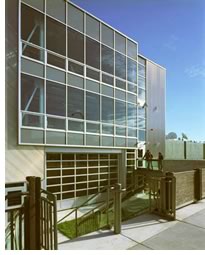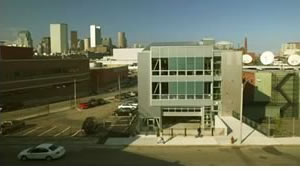

11/2004
Arrowstreet designs efficient and beautiful facility for young students.
 The
new home of Artists for Humanity EpiCenter, designed by Arrowstreet,
opened recently at the edge of Boston’s Arts District along the
south waterfront. The 22,500-square-foot building’s sustainable
design features match in innovation the unique arts program it houses.
The architects designed the Epicenter to receive a LEED™ Platinum
Certification, the highest level awarded by the U.S. Green Building Council.
The
new home of Artists for Humanity EpiCenter, designed by Arrowstreet,
opened recently at the edge of Boston’s Arts District along the
south waterfront. The 22,500-square-foot building’s sustainable
design features match in innovation the unique arts program it houses.
The architects designed the Epicenter to receive a LEED™ Platinum
Certification, the highest level awarded by the U.S. Green Building Council.
The building’s special features include:
- North- and south-facing glass walls to provide passive heating and cooling as well as maximum daylight for the interior
- Building finishes and structural elements with a high content of recycled materials
- Water-conserving fixtures
- Super insulation
- Exhaust fans and cross-ventilation instead of an air-conditioning system.
Additionally, the Massachusetts Technology Collaborative provided a grant for a rooftop photovoltaic array that generates 49.5 kilowatts of power to meet 60 percent of the building’s demand. Both NStar and KeySpan provided rebates on the building’s energy-efficiency technologies.
The architects employed industrial idioms and materials for the building, which features a ground-level gallery space with a mezzanine that accommodates groups as large as 800 people. A 24-foot-wide garage door rolls up into the ceiling to connect the gallery to a grassy courtyard. Second-level woodworking, silk-screen, and graphic design studios share natural light through translucent corrugated wall panels. The third-floor painting studio, with its dramatic 30-foot ceiling height, “enjoys commanding views of the Boston skyline and benefits from natural daylight from sunrise to sunset,” the architects say.
 Unique design process for a unique client
Unique design process for a unique client
The client, Artists for Humanity, is a nonprofit educational group founded
in 1991 by Susan Rodgerson “to bridge economic, racial, and social
divisions by providing at-risk youth with the keys to self-sufficiency
through paid employment in arts.” They chose Arrowstreet through
a competitive selection process that called for an architect who would
not only design a unique building, but was willing, as a reflection
of the Artists for Humanity’s mentoring mission, to engage the
students fully in every step of the design and construction process.
“There is no doubt that our design was strengthened and enriched by the energy and creative talents of the many young Boston artists who thrive in this unusual program,” says James P. Batchelor, AIA, Arrowstreet principal and lead designer for this project.
Even the restrooms are unique, boasting custom-made, curved metal and fiberglass stalls and long, sloped, stainless-steel sinks, both custom-designed by a local artist. “Arrowstreet’s unique design for our new building truly represents who we are and what we do,” says Rodgerson, Artists for Humanity executive/artistic director. “It is a perfect reflection of our spirit of progressive action and our mission of developing creativity, entrepreneurship, and self sufficiency in young people.”
Copyright 2004 The American Institute of Architects.
All rights reserved. Home Page ![]()
![]()
 |
||
|
||